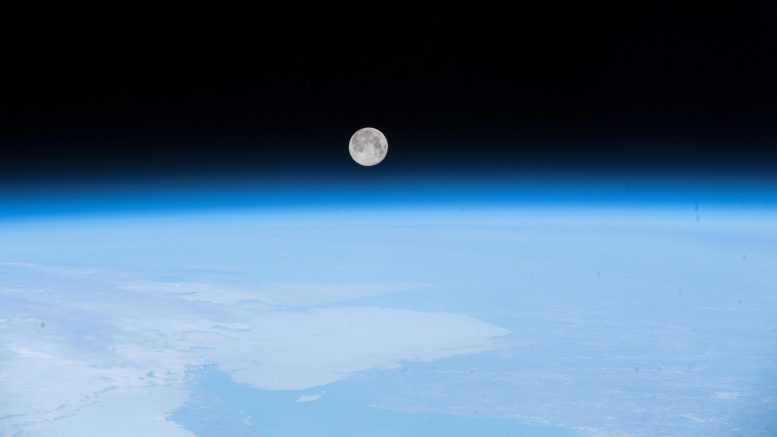
The crew of the International Space Station snapped this image of the full Moon on April 30, 2018, as the station orbited off the coast of Newfoundland, Canada. Credit: NASA
A new instrument with its eye on the Moon is taking off aboard a high-altitude NASA plane to measure the Moon’s brightness and eventually help Earth observing sensors make more accurate measurements.
The airborne Lunar Spectral Irradiance Instrument (air-LUSI) is flying aboard NASA’s ER-2 airplane. The ER-2 is able to soar above clouds, about 70,000 feet (21,000 meters) above the ground. The flights, which occur at night to avoid scattered light from the Sun, began November 13 and will wrap up November 17 from NASA’s Armstrong Flight Research Center in Palmdale, California.
The NASA-funded instrument is “measuring how much sunlight is reflected by the Moon at various phases in order to accurately characterize it and expand how the Moon is used to calibrate Earth observing sensors,” said Kevin Turpie, a professor at the University of Maryland, Baltimore County, leading the air-LUSI effort. Turpie and his team are funded by NASA’s Earth Science Division and the National Institute of Standards and Technology (NIST).
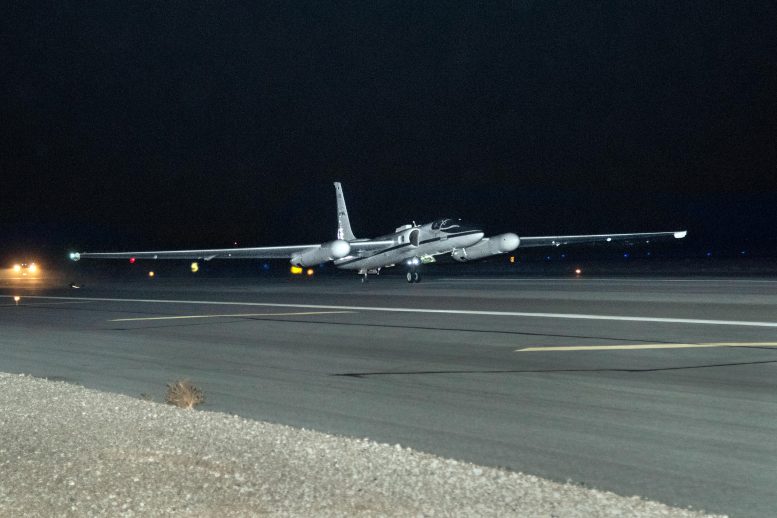
Air-LUSI takes off aboard an ER2 out of NASA’s Armstrong Flight Research Center in Palmdale, CA for an airborne campaign to measure the Moon from November 13 – 17, 2019. Credit: NASA Photo / Ken Ulbrich
How the Moon helps Earth sensors
Earth-observing sensors, like the Visible Infrared Imaging Radiometric Suite (VIIRS) aboard the NASA/NOAA/DOD Suomi National Polar-orbiting Partnership satellite and the NOAA-20 meteorological satellite, collect images of cloud cover, land surface cover, and ocean color. While these sensors are diligently doing their jobs, they also have to brace against high-energy particles and withstand ultraviolet light, which degrade their sensors over time.
To account for any changes in sensitivity, VIIRS and other satellite instruments calibrate their sensors by looking at a known reference and comparing how the most recent look compares to previous ones. If the sensor sees the reference differently than before, it knows it needs to recalibrate or adjust its sensitivity.
Currently, many instruments carry an opaque or white material, called a diffuser, that reflects sunlight and acts as a reference for sensor calibration. However, although the Sun provides a steady output, its harsh rays degrade the diffuser over time. The Moon, on the other hand, is an ideal diffuser since its reflectance of sunlight is stable and more similar to Earth’s in brightness.
Scientists have long known about the Moon’s potential. “Not long after the Apollo program, a group at the U.S. Geological Survey (USGS) developed a way of characterizing the Moon so that Earth-observing satellites could use it for calibration,” Turpie said.
The USGS Robotic Lunar Observatory (ROLO) in Flagstaff, Arizona, measured the Moon on a monthly basis from 1995 to 2003. Tom Stone, a scientist at USGS, along with Hugh Kieffer, a former scientist with USGS, developed a ROLO-based model that has and continues to be used to help calibrate Earth observing sensors in instruments, like SeaWiFS, which operated from 1997 to 2010 and measured ocean color to monitor phytoplankton. SeaWiFS looked at the Moon on a regular basis to note any changes in its instrument’s sensitivity.
Although a lot of Earth-observing mission calibration teams use ROLO, there can be large discrepancies in their lunar calibration data, Stone said. The hope is that air-LUSI’s highly accurate measurements will characterize those discrepancies and determine if they’re caused by internal biases in the ROLO model or something else. “We can’t validate ROLO calibrations to any better than 5%,” Stone said. “Air-LUSI can improve ROLO or determine what needs to be improved.”
Air-LUSI’s novel instruments are able to obtain highly accurate lunar spectral irradiance measurements that will have the lowest ever uncertainty (less than 1%), Turpie said, which establishes the Moon as an absolute calibration reference and helps remote sensing scientists determine if Earth observing sensors, like VIIRS, are recording actual changes on Earth or changes in their instruments.
Although Earth-observing missions can look at the Moon at the same time and phase every month as a way to notice trends in their instruments’ sensitivity, they haven’t yet been able to use the Moon as an absolute calibration reference, Kurt Thome, a project scientist for Earth-observing missions at NASA’s Goddard Space Flight Center in Greenbelt, Maryland, said.
What does it mean to be an absolute calibration reference? If you compare two people standing next to each other, it’s easy to see which person is taller. However, if these two people are at opposite ends of the world, the only way to compare their heights would be with an absolute reference, like a ruler. Air-LUSI is aiming to make the Moon an absolute calibration reference, which means an instrument would only need to look at the Moon once to determine the instrument’s absolute sensitivity, while comparing looks over time to see if the instrument is changing, Thome said.
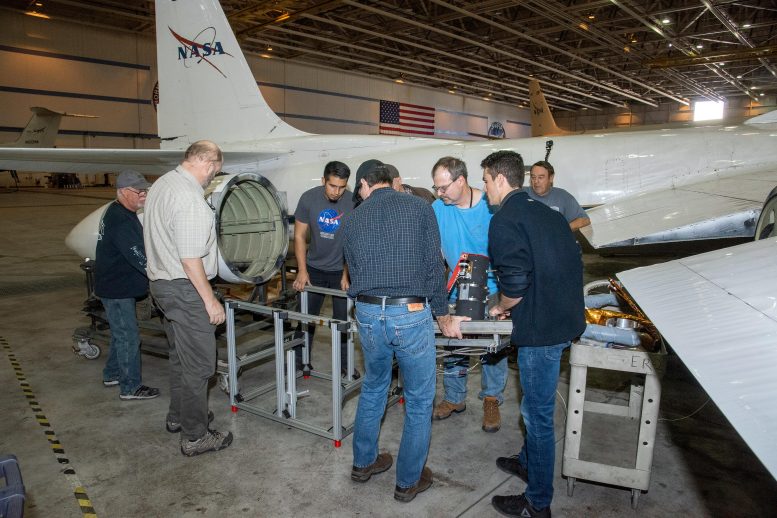
The air-LUSI crew and ground crew from NASA’s Armstrong Flight Research Center in Palmdale, CA place air-LUSI’s component from the wingpod to the stand for hangar calibration. Credit: NASA/ Ken Ulbrich
A collaborative effort
To gather information about the Moon, air-LUSI includes three subsystems, which require expertise from multiple organizations, said Turpie. His team includes people from NIST, the USGS, the University of Guelph in Ontario, Canada, and NASA.
The first component is called IRIS, short for Irradiance Instrument Subsystem, and was designed by NIST. It includes an instrument able to take precise measurements of the Moon while sitting in a temperature and pressure-controlled enclosure.
The second component is a robotic telescope mount called ARTEMIS (Autonomous, Robotic Telescope Mount Instrument Subsystem) designed and built by the University of Guelph. ARTEMIS has a camera that scans the sky until it finds the Moon and directs the telescope to point at it and keep it locked in place, regardless of aircraft motion.
The final component is the High-altitude ER-2 Adaptation, or HERA. HERA includes all the connective tissue, like cables and mounting equipment, which holds the instrument together and to the plane, as well as the thermal stabilizing components. Air-LUSI is able to record data during flight and download the data from the plane to the ground.
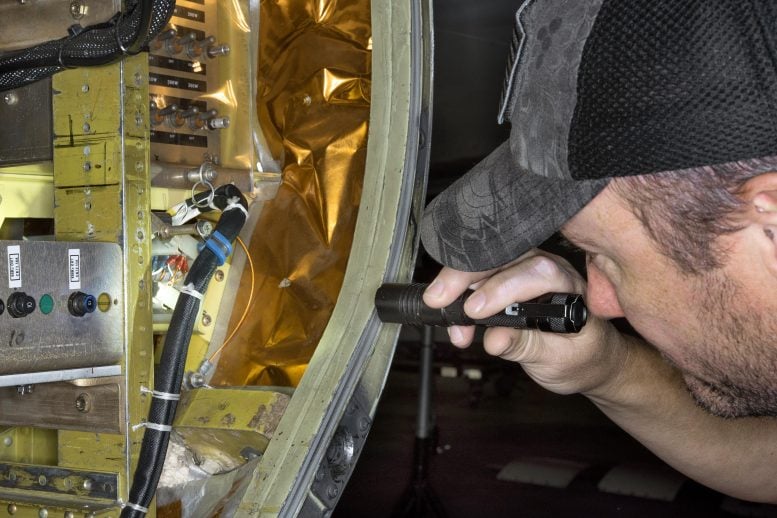
Ground crewman at NASA’s Armstrong Flight Research Center in Palmdale, CA install a rail to support the Autonomous, Robotic Telescope Mount Instrument Subsystem, which is part of air-LUSI and has a camera that scans the sky to find the Moon. Credit: NASA Photo / Ken Ulbrich
One small step for air-LUSI, one giant leap for Earth science
In the near future, an operational weather satellite would benefit from being able to look to the Moon as an absolute calibration reference, Thome said. This includes the currently-flying Suomi National Polar-orbiting Partnership (Suomi NPP) and Joint Polar Satellite System-20 (JPSS) satellites, as well as those to come in the future from both NOAA and their international partners. Each satellite could calibrate its instruments by the Moon to compare how its sensors are holding up to the other satellites’ sensors, Thome said.
NASA’s upcoming Ocean Color Imager, aboard the Phytoplankton Aerosols Clouds and ocean Ecology (PACE) satellite, also intends to use the Moon for calibration, Turpie said.
“Air-LUSI’s Moon measurements make it easier for people to justify using the Moon to calibrate their instruments,” Thome said.

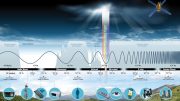




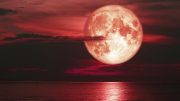
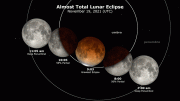
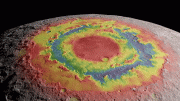
Be the first to comment on "air-LUSI: New Moon-Seeking Sensor Aims to Improve NASA’s Earth Observations"